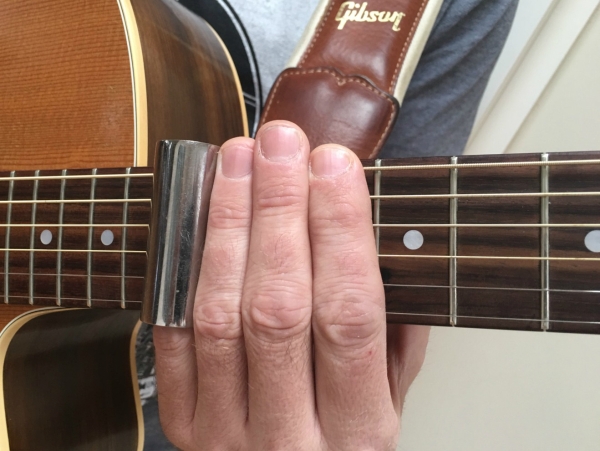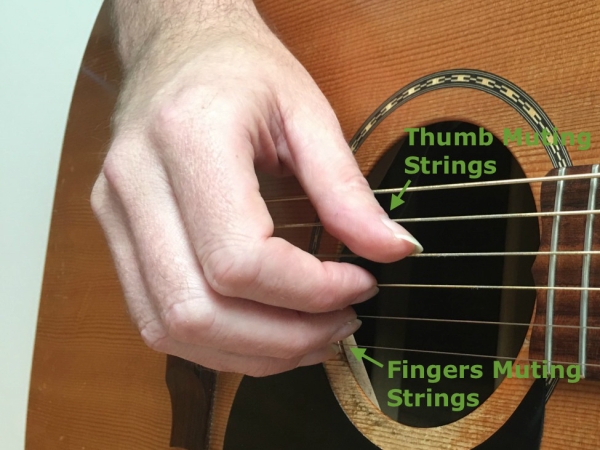One thing I love to do is expand the scope of sound I can get when playing guitar. One technique that is great for doing exactly that is slide guitar.
A slide is an object often made from brass, glass, or metal, that is cylindrical in shape, and placed on one of the fingers of your fretting hand. It basically turns your instrument into a one fingered fretless guitar, as you glide it up and down the length of the strings (more on this shorty).
The result is a very cool and unique sound that cannot be emulated any other way.
Here are some reasons why you should consider learning how to play slide guitar?
Read on to discover the basics to playing slide guitar. It's easier than you think.
The Slide
Slides are made from various types of materials including glass, brass, and metal. Each type of slide produces a different sound/tone, not only due to the material used to make the slide, but also the thickness and size of the slide itself.
I won't get into the details of each type of slide here, however much like a plectrum, it is well worth trying out a range of slides to see what feels and sounds best to you. Most likely you will have a few different slides at your disposal to use for various situations.
You can place the slide on any finger of your picking hand. It will come down to what feels comfortable to you, and what you want to be able to do. If you are wanting to integrate slide playing with 'normal' guitar playing, then it would be in your best interest to put the slide on your pinky finger, freeing up your other fingers to fret notes and chords.
Whichever finger you decide to use, make sure you hold the slide more or less parallel to the frets of your guitar. Keep your fingers, including the one with the slide on it, together, not separated, and be sure all fingers are lightly touching the strings.
This serves two purposes:
1. Your fingers will dampen the strings, preventing any unwanted sound when moving up and down the fretboard with the slide. Check the picture for reference:

2. Keeping your fingers together enables you to keep the slide sitting above the second knuckle of the finger it is on. You don't want the slide to slip down to the base of the finger. You should still be able to bend the finger the slide is on. Check the picture for reference:

When using the slide to sound notes, you need to place it directly over the top of the fret, not in-between. In fact, you don't even need the frets to sound notes with the slide, their only purpose is as a visual guide as to where to put the slide to sound a note.
Keep the pressure of the slide against the string very light. Most people push way too hard at first, much like they are fretting notes with their fingers.
A guitar with a higher action (ie. distance of string to fretboard) is ideal as this will prevent the slide hitting the frets, creating unwanted sounds.
The Picking Hand
Slide guitar can be played with a plectrum or with your fingers. Each approach will provide a different tone and have it's pros and cons. You may choose to do both, depending on the situation. I do this myself but find most the time I use my fingers.
Your picking hand also mutes out strings not being used to prevent unwanted noise. You'll find the thumb is best placed to mute out lower strings, while your fingers, at least those not being used at the time, are best for muting out higher strings.
So let's say I am sounding a note on the second string with the slide. The thumb of my picking hand would rest against the lower 4 strings as I did this, and either my middle or ring finger would rest on the 1st string muting it out.
Which finger I use to mute here will depend on which finger is busy plucking the second string at the time. Most likely my index will pluck the 2nd string in this case, while my middle and/or ring finger mutes out the top string, by resting on it. Check the picture for reference:

While this seems like a lot to think about to simply sound one note, it's well worth the investment of time to train your slide playing this way. If you ignore this detail you will sound average at best. Before long it will become all very second nature to you.
Open tunings and slide guitar playing go hand in hand. This is because open tunings set your guitar up in a way that makes it easy to fret chords with your slide.
For example, an open G tuning sets your guitar up where you can play single fret bar chords. Pretty handy considering your slide can only be in a single fret at a time, don't you think?
Here is an example of a simple bar chord in an open G tuning, played with a slide:

From this simple bar chord you can derive many cool slide guitar licks. Here are just a few to get you going:





Notice we are mostly targeting notes in the bar chord to create our licks here.
When playing the above, keep everything we have covered in mind regarding your slide guitar technique. Things will get much easier for you in only a short amount of time.
Specializing in online acoustic guitar lessons, Simon Candy is based in Melbourne, Australia where he runs his own guitar school.